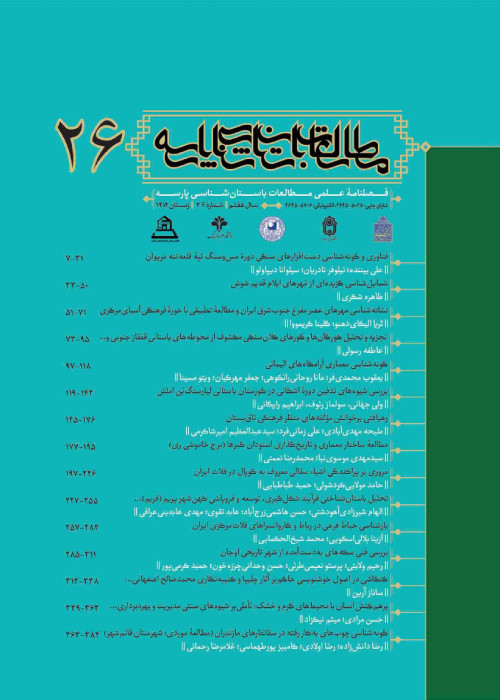Banquet Beaker; Interpreting an Ancient Object in the Pase of Pottery Beakers from Mala Mcha, Kani Koter and Hasanlu
Author(s):
Article Type:
Research/Original Article (دارای رتبه معتبر)
Abstract:
Among the ancient motifs from Iran and Mesopotamia, some pictures showing special shaped beakers can be seen but unfortunately no explicit comment has been made on the nature and function of these forms by researchers. Recently, 7 pottery beakers have been found in a Mannaean cemetery (Mala Mcha) and and Iron Age grave (Kani Koter) in northwestern Iran and authors are believed that their shape and possible function are compatible with some of these ancient motifs dating back from the third millennium B.C. to the Achaemenid period. A glazed beaker from Tepe Hasanlu which belongs to Iron Age II also has the same characteristics as the Mala Mcha and Kani Koter examples. Considering the symbolic meaning of the Lotus flower in ancient cultures, as well as their form and decoration, it seems that the Mala Mcha, Kani Koter and Hasanlu pottery beakers have a special application. Previously some researchers in some cases have interpreted these motifs as a Barsom (Barsam) or flower (often lotus). The authors propose that these objects that can be seen on ancient reliefs or ivories are simple or painted beakers equivalent to the clay beakers unearthed in these sites. Probably this type of beaker was not used as normal container, but it seems to have been utilized by high-level people during special events and banquets perhaps for drinking prized liquids. In addition, it seems that the samples of the Mala Mcha, Kani Koter and Hasanlu in terms of shape and possible there function, are comparable with some of the patterns of the motifs discussed in this paper. The grave of Kani Koter is rich and belonged to a warrior of high status. Also the graves of Mala Mcha which had pottery beakers were richer than other graves, and it seems that the users of them have superior position over others. The glazed beaker of Hasanlu was as well as obtained from a room with local and Mesopotamian specimens in a special room. In ancient motifs, users of these objects have a superior social position than others. In this paper, in addition to comparing the shape of the beakers of Mala Mcha, Kani Koter and Hasanlu with the remaining ancient motifs, Chromatography experiments were carried out which unfortunately, did not receive any laboratory data on its application.
Keywords:
Language:
Persian
Published:
Parseh Journal of Archaeological Studies, Volume:3 Issue: 7, 2019
Pages:
43 to 56
magiran.com/p2008541
دانلود و مطالعه متن این مقاله با یکی از روشهای زیر امکان پذیر است:
اشتراک شخصی
با عضویت و پرداخت آنلاین حق اشتراک یکساله به مبلغ 1,390,000ريال میتوانید 70 عنوان مطلب دانلود کنید!
اشتراک سازمانی
به کتابخانه دانشگاه یا محل کار خود پیشنهاد کنید تا اشتراک سازمانی این پایگاه را برای دسترسی نامحدود همه کاربران به متن مطالب تهیه نمایند!
توجه!
- حق عضویت دریافتی صرف حمایت از نشریات عضو و نگهداری، تکمیل و توسعه مگیران میشود.
- پرداخت حق اشتراک و دانلود مقالات اجازه بازنشر آن در سایر رسانههای چاپی و دیجیتال را به کاربر نمیدهد.
In order to view content subscription is required
Personal subscription
Subscribe magiran.com for 70 € euros via PayPal and download 70 articles during a year.
Organization subscription
Please contact us to subscribe your university or library for unlimited access!



